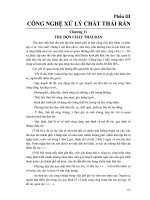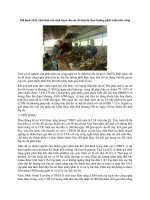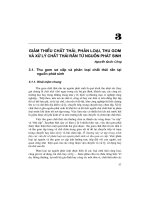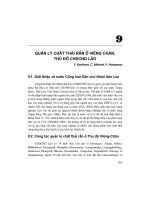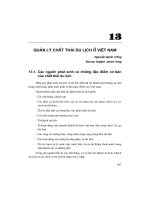CHƯƠNG 13. XỬ LÝ CHẤT THẢI RẮN
Bạn đang xem bản rút gọn của tài liệu. Xem và tải ngay bản đầy đủ của tài liệu tại đây (1.27 MB, 22 trang )
Chapter 13
Xử lý chất thải rắn
•Composting
•Incineration
•Landfill
•Recycling
1
Compost
Organic matter that has been decomposed and recycled as a
fertilizer and soil amendment.
The process: simply piling up waste outdoors and waiting for the
materials to break down between 5-6 weeks or even more.
Measured inputs of water, air and carbon- and nitrogen-rich
materials.
Worms and fungi further break up the material.
Aerobic bacteria manage the chemical process by converting the
inputs into heat, CO2 and NH4+. The NH4+ is further converted by
bacteria into plant-nourishing NO2- and NO3- through the process
of nitrification.
Organic ingredients intended for composting can alternatively be
used to generate biogas through anaerobic digestion.
2
Anaerobic digestion
Bacterial hydrolysis of the input materials to break down insoluble
organic polymers, such as carbohydrates.
Acidogenic bacteria then convert the sugars and amino acids into carbon
dioxide, hydrogen, ammonia, and organic acids
Acetogenic bacteria then convert these resulting organic acids into
acetic acid, along with additional ammonia, hydrogen, and carbon
dioxide.
Methanogens convert these products to methane and carbon dioxide
3
Anaerobic digestion-Residence time
Single-stage thermophilic digestion, residence times may be in the
region of 14 days
Two-stage mesophilic digestion, residence time may vary between
15 and 40 days
UASB digestion, hydraulic residence times can be 1 hour to 1 day,
and solid retention times can be up to 90 days
Continuous digesters have mechanical or hydraulic devices,
depending on the level of solids in the material, to mix the
contents, enabling the bacteria and the food to be in contact
4
Incineration
high calorific
value
low calorific value
5
High calorific waste
Medical waste incinerators
The medical waste incinerator is a high temperature kiln.
Biohasardous waste such as medical and hospital waste can only be
totally desinfected by thermal treatment.
To be sure of total desinfection, the temperature in the combustion
chamber has to exceed 1000 degrees
Rotary kiln incinerator is the most used technology for the destruction of
medical waste, because of its versatility,its continuous operation and
because of its self cleaning properties (no need for inside cleaning)
Industrial and hazardous waste incinerators
Industrial wastes are mostly highly calorific and,as such, generate very
high temperatures (> 1100 degr.C) while being oxidised.. Those high
temperatures can only be safely handled in a rotary kiln incinerator.
6
High caloric waste
7
Rotary kiln
8
Rotary kiln
9
moving grate incinerator
Primary combustion air is supplied through
the grate from below =>cooling the grate .
Cooling is important for the mechanical
strength of the grate, and many moving
grates are also water-cooled internally.
Secondary combustion air is supplied into the
boiler at high speed through nozzles over the
grate. It facilitates complete combustion of
the flue gases by introducing turbulence for
better mixing and by ensuring a surplus of
oxygen.
10
11
Fluidized incinerator
Supplying the first air to the fourth airs
(1,2,3,4) into the incinerator from
optimal positions => oxidation of Fuel
NOx is restrained
Long residence time of combustion gas
in the temperature range of 800 to 900°
C => suppress NOx, CO, dioxine, and
dissolution of dioxine is proceeded
10. Fuel input
12
Đốt nhiệt phân
Nhiệt phân là quá trình phân hủy chất thải rắn do nung
nóng trong điều kiện không có oxy
Nhiệt phân bằng hồ quang-plasma: thực hiện đốt ở nhiệt
độ cao 10.0000C để tiêu hủy chất thải có tính độc cực
mạnh. Sản phẩm là H2, CO, khí axit, tro
13
Quá trình nhiệt phân được
tiến hành trong buồng đốt
sơ cấp của lò nhằm chuyển
các thành phần ở thể rắn và
lỏng của chất thải thành thể
khí (HC, CO, H2…) nhờ nhiệt
cung cấp từ mỏ đốt nhiên
liệu. Quá trình nhiệt phân
được thực hiện trong điều
kiện thiếu oxy và ở nhiệt độ
500-600oC.
Buồng đốt thứ cấp phân huỷ
các chát ô nhiễm ở nhiệt độ
cao (trên 1100oC). Toàn bộ
lượng không khí cấp bổ
sung, những chất cháy thể
khí từ buồng sơ cấp sang,
kể cả các chất ô nhiễm hữu
cơ mạch vòng như dioxin và
furois sẽ bị đốt cháy hoàn
tòan tạo thành CO2 và H2O.
14
Đốt nhiệt phân
15
16
Gassification
Converting organic materials into CO, H, CO2, and CH4 through really
high temperatures without combustion (burning)
17
18
Landfill design
19
Landfill
20
21
22
